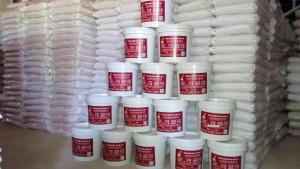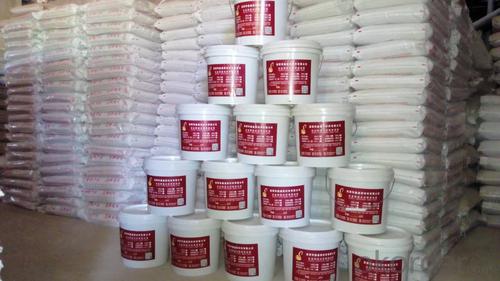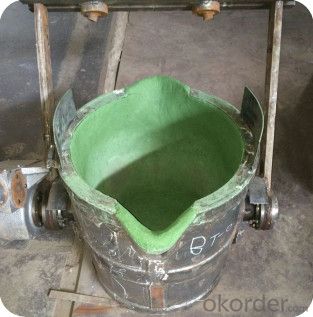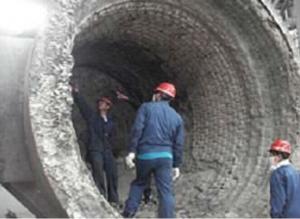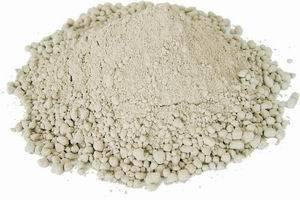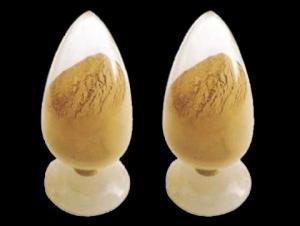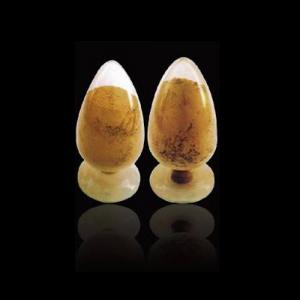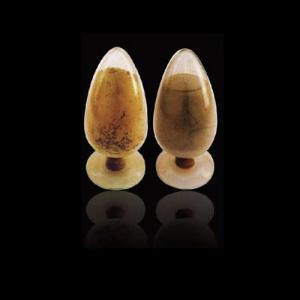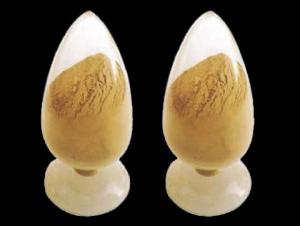RAMMING MIX REFRACTORY MATERIAL FOR INDUCTION FURNACE
- Loading Port:
- Shanghai
- Payment Terms:
- TT or LC
- Min Order Qty:
- 20 kg
- Supply Capability:
- 100000000000000 kg/month
OKorder Service Pledge
OKorder Financial Service
You Might Also Like
Technial Data Sheet of Ramming Mix for Induction Furnace for Iron & Steel Industry
CODE | MATERIAL | PHYSICAL PROPERTIES | CHEMICAL ANALYSIS (WEIGHT %) | |||||
Particle size(mm) | Fe2O3(%) | Cr2O3(%) | Al2O3(%) | CaO (%) | MgO (%) | SiO2 (%) | ||
IF-QZ | Quartz Ramming Mix | 0~6 | 98 | |||||
IF-Mg1 | Magnesia Ramming Mix | 0~10 | 4 | 1 | 2.5 | 91 | 1.5 | |
IF-Mg2 | Magnesia Ramming Mix | 0~10 | < 1.5 | 2 | 96 | < 2 | ||
IF-MgAl | Magnesia Alumina Ramming Mix | 0~6 | 0.5 | 8 | 1 | 90 | 0.5 | |
IF-MgAlS | Magnesia Alumina Mix powder Ramming Mix | 0~6 | 87 | 1 | 10 | 1 | ||
IF-MgCr | Magnesia Chrome Ramming Mix | 0~6 | 12 | 21 | 6 | 58 | 1.5 | |
IF-MgS | Magnesia Mix Ramming Mix | 0~6 | 17 | 80 | ||||
IF-Al | High Alumina Ramming Mix | 0~8 | > 70 | < 26 | ||||
Product Photo of Ramming Mix
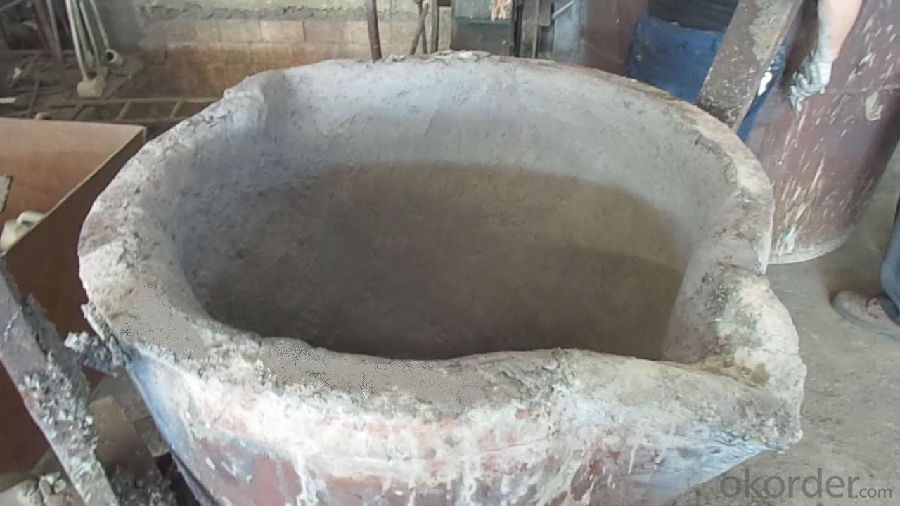
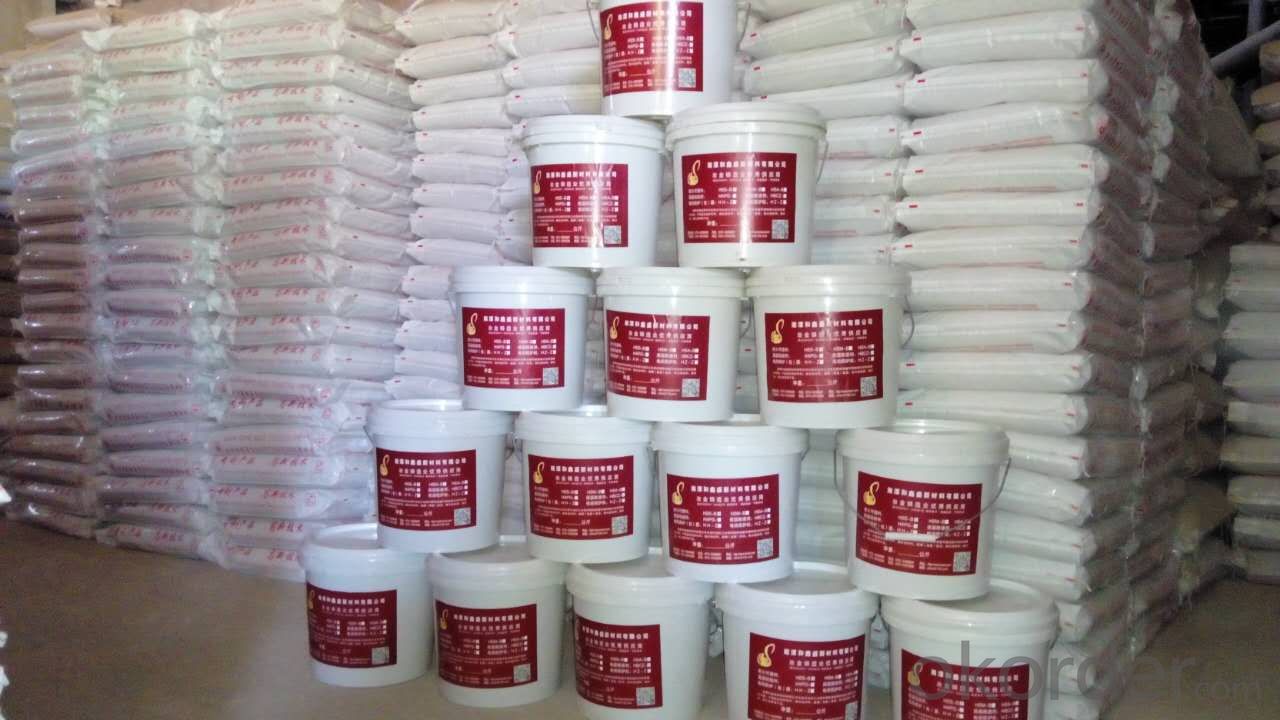
Installation of Ramming Mix
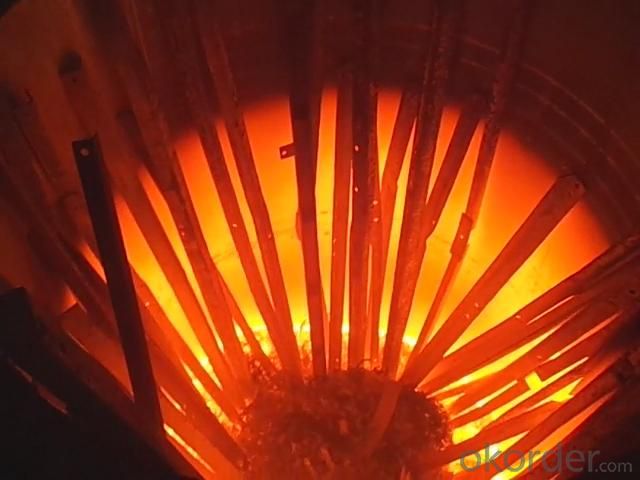
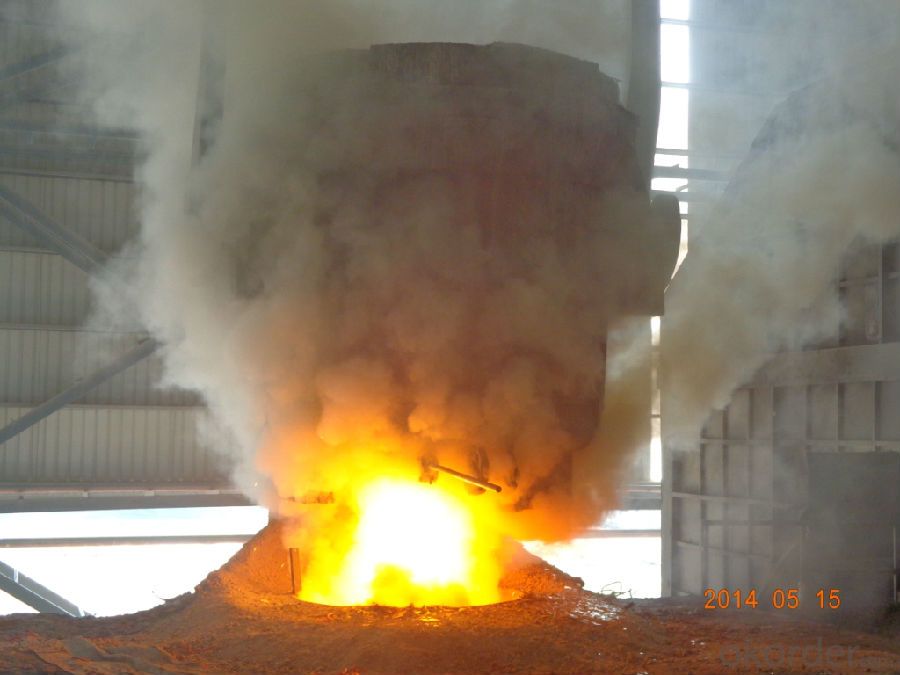
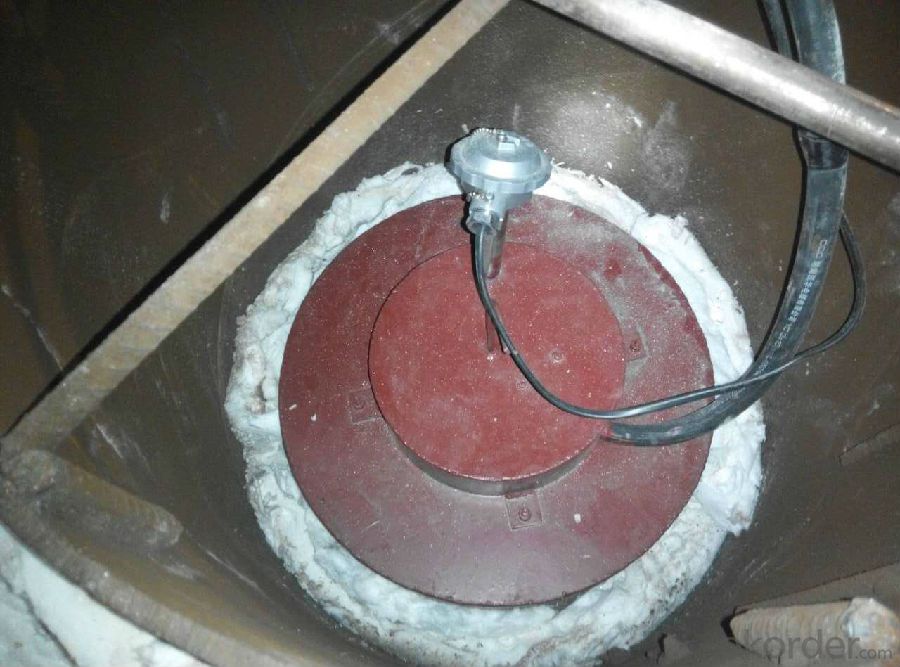
Questionnaire for Induction Furnace
ITEMS | CONTENT | ||
★Usually smelt metal types: | ( ) | ||
★Furnace Size/Ton | ( ) | ||
Furnace dimension | Inside diameter/mm | ( ) | |
Height/mm | ( ) | ||
Turnover rate (Tap to Tap time) | Normal heating up time: | ( ) | |
Continuous working? | |||
★Casting temp(Tapping Temp) | Max/℃ Min/℃ | ( ) ( ) | |
★Working Lining(Current) | Lining Materials type | ||
Additives for lining | □ yes ( ) Exp: Boric acid, sodium silicate etc. □ No | ||
Wall thickness | ( ) | ||
Bottom thickness | ( ) | ||
Construction form | ( ) Example: Dry Vibrating or Ramming, water required or not, additives required or not | ||
Steel former | ( ) Example: Take out or smelt into the first heat. | ||
Average life/heats
| ( ) Example: Total life:200-220 with one repair on 30 – 50 heats | ||
★Installation tools | □ Aerodynamic Vibrator □ Electronic Vibrator □ Other ( ) | ||
Induction Coil Grout(Current) | Materials type | ||
Life/heats | ( ) | ||
★The type and amount additives for the slag reduction | ( ) | ||
Damage cause | ( ) Example: Spalling , Corrosion, cracks, leakage | ||
- Q: What are the main factors affecting the thermal expansion of monolithic refractories?
- The main factors affecting the thermal expansion of monolithic refractories include the chemical composition of the refractory material, the temperature at which it is exposed, and the rate at which it is heated or cooled. Other factors such as the presence of impurities, the porosity of the material, and the type of bonding agents used can also influence the thermal expansion behavior of monolithic refractories.
- Q: How do monolithic refractories contribute to reducing emissions in iron and steel processes?
- Monolithic refractories play a crucial role in reducing emissions in iron and steel processes by providing superior insulation, increased energy efficiency, and improved control over the production process. These refractories are designed to withstand extreme temperatures and harsh conditions, effectively minimizing heat loss and reducing the need for excessive fuel consumption. By creating a highly insulated environment, monolithic refractories enable better temperature control, leading to optimized combustion and reduced emissions of greenhouse gases. Additionally, their high resistance to wear and corrosion helps prevent the formation of pollutants, thereby contributing to a cleaner and more sustainable iron and steel industry.
- Q: What are the typical operating temperatures for monolithic refractories?
- The typical operating temperatures for monolithic refractories vary depending on the specific composition and type of refractory material. However, in general, monolithic refractories are designed to withstand high temperatures ranging from 1500°C (2732°F) to 1800°C (3272°F) and even higher in some cases. These refractories are commonly used in industries such as steelmaking, cement production, glass manufacturing, and petrochemical processing, where they are subjected to extreme thermal conditions. Different types of monolithic refractories have different temperature limits. For instance, basic refractories made of magnesia or dolomite can withstand temperatures up to 1800°C (3272°F). On the other hand, alumina-based refractories can typically handle temperatures up to 1700°C (3092°F). Silicon carbide-based refractories have even higher temperature resistance, with the ability to withstand temperatures above 2000°C (3632°F). It is crucial to select the appropriate monolithic refractory material based on the specific operating temperature requirements of the application. Using refractories beyond their recommended temperature limits can cause thermal shock, spalling, or reduced performance, leading to potential equipment failure or safety hazards. Therefore, consulting with refractory manufacturers or experts in the field is essential to ensure the correct selection and optimal performance of monolithic refractories in high-temperature applications.
- Q: What are the environmental considerations associated with monolithic refractories?
- The environmental considerations associated with monolithic refractories primarily revolve around their production and disposal. The manufacturing process of monolithic refractories involves high energy consumption and emissions, contributing to carbon dioxide and other greenhouse gas emissions. Additionally, some raw materials used in their production, such as silica, can have negative environmental impacts during extraction. In terms of disposal, monolithic refractories are typically difficult to recycle due to their composition and structure. As a result, they often end up in landfills, which can contribute to pollution and waste management issues. Overall, the environmental considerations associated with monolithic refractories highlight the need for sustainable manufacturing practices, improved waste management strategies, and the development of alternative refractory materials that have less negative environmental impact.
- Q: What are the key properties of monolithic refractories?
- The key properties of monolithic refractories include high strength, thermal shock resistance, erosion and abrasion resistance, good thermal conductivity, and excellent chemical resistance. These properties make monolithic refractories suitable for applications where high temperatures, harsh environments, and mechanical stresses are present, such as in furnaces, kilns, and reactors.
- Q: How do monolithic refractories improve the efficiency of ladle and tundish preheaters?
- Monolithic refractories improve the efficiency of ladle and tundish preheaters by providing excellent insulation, high thermal conductivity, and resistance to thermal shock. These properties allow for better heat retention, reduced heat loss, and quicker and more uniform heating of the ladle and tundish, ultimately improving the overall efficiency of the preheating process.
- Q: How do monolithic refractories contribute to energy efficiency in iron and steel manufacturing?
- Monolithic refractories contribute to energy efficiency in iron and steel manufacturing through their superior insulation properties and ability to withstand high temperatures. These refractories minimize heat loss, reducing the energy required for heating and maintaining the desired temperature in the manufacturing process. Additionally, their durability and resistance to thermal shock help to extend the lifespan of furnaces and other equipment, reducing the need for frequent repairs or replacements, further enhancing energy efficiency.
- Q: What are the advantages of using monolithic refractories in the iron and steel industry?
- Using monolithic refractories in the iron and steel industry offers several advantages. Firstly, they have excellent thermal insulation properties, allowing them to withstand and retain high temperatures. This is crucial in the manufacturing process as it ensures structural integrity, reduces the risk of failure, and maintains operational efficiency. Secondly, monolithic refractories have superior corrosion resistance. This protects equipment and structures from degradation caused by harsh chemicals and corrosive agents. It extends the lifespan of the refractories, reduces maintenance costs, and minimizes downtime. Another advantage is the versatility of monolithic refractories. Unlike traditional refractory bricks, they can be cast or sprayed into various shapes and sizes. This makes installation easier and allows for better lining design and improved performance. They can also be easily repaired or patched, minimizing production disruptions. Furthermore, monolithic refractories have excellent mechanical strength and abrasion resistance. This ensures they can withstand the constant movement and processing of materials in the industry without compromising performance. Lastly, using monolithic refractories can lead to cost savings. They require less labor and time for installation, resulting in reduced costs. Their longer lifespan, resistance to corrosion and thermal shock, also reduces the need for frequent replacements, minimizing maintenance and downtime costs. In conclusion, monolithic refractories offer advantages such as thermal insulation, corrosion resistance, versatility, mechanical strength, and cost savings. They are an ideal choice for lining furnaces, ladles, and other equipment used in the production of iron and steel.
- Q: What are the recommended storage and handling practices for monolithic refractories?
- The recommended storage and handling practices for monolithic refractories are crucial to ensure their optimal performance and longevity. Here are some key practices to follow: 1. Storage: Monolithic refractories should be stored in a clean, dry, and well-ventilated area. The storage facility should be protected from moisture, extreme temperatures, and direct exposure to sunlight. Ideally, the refractories should be stored on pallets or racks to prevent contact with the ground and minimize the risk of damage. 2. Handling: It is essential to handle monolithic refractories with care to avoid any physical damage. Refractories should be lifted and moved using appropriate lifting equipment, such as forklifts or cranes, to prevent excessive stress or strain on the material. Avoid dropping or dragging the refractories, as this can lead to cracks or fractures. 3. Packaging: If the monolithic refractories are supplied in packaging, it is important to inspect the packaging for any signs of damage or moisture before accepting the delivery. Damaged packaging can indicate potential damage to the refractory material. If any anomalies are noticed, it is advisable to inform the supplier immediately. 4. Moisture control: Monolithic refractories are susceptible to moisture absorption, which can lead to reduced performance and structural integrity. It is crucial to protect the refractories from direct contact with water or excessive humidity during storage and handling. If refractories become wet, they should be dried thoroughly before use to eliminate any absorbed moisture. 5. Stack height: When storing monolithic refractories, it is important to consider the stack height. Excessive stacking can result in pressure on the lower layers, leading to deformation or cracking. Follow the manufacturer's recommendations for maximum stack height to ensure the refractories' structural integrity. 6. Regular inspection: Regularly inspect the refractory material for any signs of damage or degradation during storage and handling. Look for cracks, spalling, or any other visible abnormalities. If any issues are identified, consult the manufacturer or a refractory expert for guidance on whether the material is still suitable for use. By following these recommended storage and handling practices, you can minimize the risk of damage to monolithic refractories and optimize their performance, ultimately extending their service life and ensuring their effectiveness in high-temperature applications.
- Q: How does the choice of monolithic refractory impact the overall cost of iron and steel production?
- The choice of monolithic refractory can significantly impact the overall cost of iron and steel production. Monolithic refractories are used to line the furnaces and other high-temperature areas in the production process, providing insulation and protection against extreme heat and chemical erosion. The cost of monolithic refractories varies depending on their composition, quality, and performance properties. Opting for high-quality monolithic refractories can increase their initial cost but can result in longer refractory lifespan, reduced downtime for repairs, and improved productivity. On the other hand, choosing lower-quality or inadequate refractories may save costs initially but can lead to frequent replacements, increased downtime, and decreased production efficiency. Additionally, monolithic refractories play a crucial role in energy efficiency. Using refractories with better insulation properties can help to reduce heat loss, leading to lower energy consumption and cost savings in the long run. Therefore, the selection of the right monolithic refractory is crucial in iron and steel production, as it directly impacts the overall cost by influencing refractory lifespan, productivity, maintenance, energy consumption, and overall operational efficiency.
Send your message to us
RAMMING MIX REFRACTORY MATERIAL FOR INDUCTION FURNACE
- Loading Port:
- Shanghai
- Payment Terms:
- TT or LC
- Min Order Qty:
- 20 kg
- Supply Capability:
- 100000000000000 kg/month
OKorder Service Pledge
OKorder Financial Service
Similar products
Hot products
Hot Searches
Related keywords
